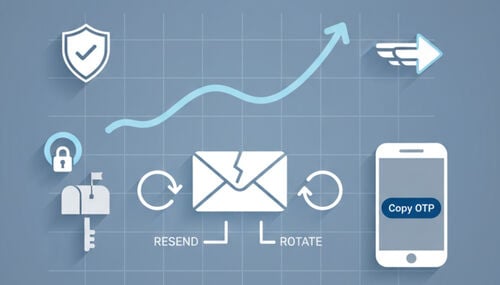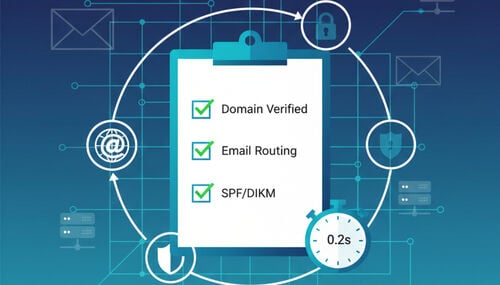Using Temporary Email for Travel Deals, Flight Alerts, and Hotel Newsletters
The modern traveler lives in two worlds. In one tab, you are juggling flight searches, hotel comparisons, and limited-time promos. In the other, your primary inbox is quietly filling up with newsletters you never quite remember subscribing to. Temporary email gives you a way to enjoy travel deals and alerts without turning your primary email into a permanent dumping ground.
This guide walks through how to use disposable and reusable temporary email addresses to manage travel deals, flight alerts, and hotel newsletters. You will learn where temporary email services shine, where they become dangerous, and how to build a simple email system that can survive years of trips, rebookings, and loyalty promotions.
Quick access
TL;DR
Understand Travel Inbox Chaos
Map Your Travel Email Flow
Use Temp Mail for Travel Deals
Separate Alerts From Real Tickets
Organize Hotel and Loyalty Emails
Build a Nomad-Proof Email System
Avoid Common Travel Email Risks
FAQ
TL;DR
- Most travel emails are low-value promotions that often bury critical messages, such as schedule changes and invoices.
- A layered setup, comprising a primary inbox, a reusable temporary email, and a true throwaway, keeps travel spam away from life-critical accounts.
- Use a temporary email for flight deals, newsletters, and low-risk alerts, not for tickets, visas, or insurance claims.
- Reusable temporary mail services, such as tmailor.com, let you keep an address "alive" for months while limiting inbox clutter.
- Before using a disposable address on any travel site, ask: "Will I still need this email trail in six to twelve months?"
Understand Travel Inbox Chaos

Travel generates a noisy, never-ending email trail, and only a few of those messages truly matter once your trip is over.
Why Travel Emails Pile Up So Fast
Every trip creates a miniature email storm. You start with fare alerts and destination inspiration, then move into booking confirmations, followed by a wave of "last chance" upgrades, loyalty campaigns, survey requests, and cross-sells. Multiply that by a couple of trips per year and a handful of airlines, and your inbox quickly looks like a low-budget travel magazine you never wanted to subscribe to.
Behind the scenes, each booking and newsletter sign-up is just another entry in a database that points back to your email address. The more services you use with a single address, the more that identifier gets shared, synced, and targeted. If you want to understand this flow in detail - MX records, routing, and inbox logic - a technical deep dive, such as how temporary email works behind the scenes, will show you exactly what happens to every travel message from send to delivery.
The Hidden Cost of a Messy Travel Inbox
The apparent cost is irritation: you waste time deleting promos you never read. The less obvious cost is risk. When your inbox is noisy, essential messages can easily get lost in the clutter: a gate change email, a rebooked connection after a delay, a room cancellation due to a failed card, or an expiring voucher that genuinely matters to you.
A messy travel inbox also blurs the line between legitimate operational messages and phishing attempts. When you receive dozens of lookalike "urgent" emails from airlines, OTAs, and loyalty programs, it becomes harder to spot the one dangerous message that slipped through your filters.
Types of Travel Emails You Actually Need
Not all travel emails deserve the same level of care. It helps to classify them before you decide where each type should land:
- Mission-critical: tickets, boarding passes, schedule changes, cancellation notices, hotel check-in details, invoices, and any email that could be needed for refunds, insurance, or compliance.
- Valuable but non-essential items include loyalty point summaries, upgrade offers, "Your seat has Wi-Fi," destination guides from your airline or hotel chain, and receipts for small add-ons.
- Pure noise: generic destination inspiration, routine newsletters, blog digests, and "we thought you might like this package" messages.
A temporary email is most potent when it filters out the noise and some of the "useful but non-essential" traffic. At the same time, your primary inbox handles the mission-critical aspects of your travel life.
Map Your Travel Email Flow
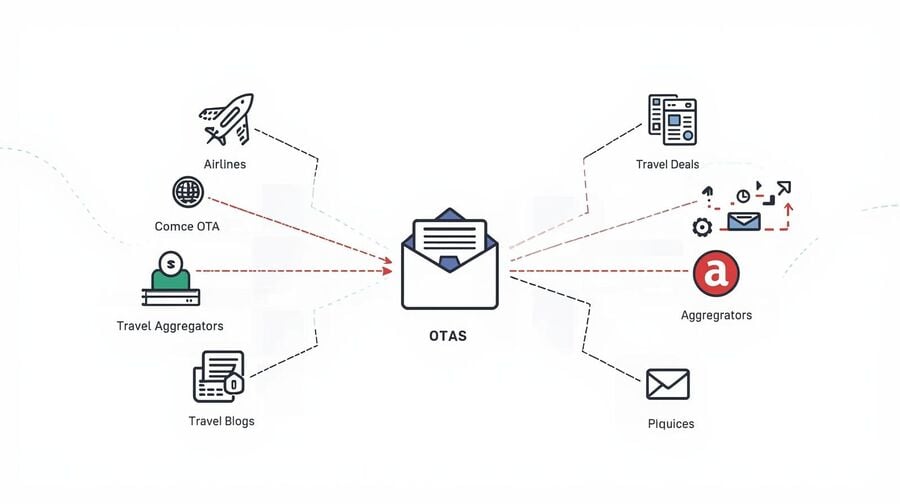
Before you redesign anything, you need to see every place where travel brands capture and reuse your email address.
Where Airlines and OTAs Capture Your Email
Your email address enters the travel world at several points. It might be collected directly by an airline during booking, captured by an online travel agency (OTA) such as Booking.com or Expedia, or saved by meta-search tools that offer "price drop" alerts. Each layer adds another potential stream of promos and reminders.
Even if you never complete a booking, simply starting a checkout flow can create a record that later drives cart-abandonment reminders and follow-up offers. From a privacy and inbox management perspective, those "almost bookings" are prime candidates for a temporary email.
How Hotel Chains and Loyalty Programs Lock You In
Hotel groups have a strong incentive to stay in touch with you after your stay. They use your email to connect bookings across properties, award points, send feedback surveys, and dangle targeted offers. Over a few years, that can turn into hundreds of messages, many of which are only marginally relevant.
Some travelers enjoy this relationship and want a complete history tied to their primary inbox. Others prefer to ring-fence these communications into a separate address. For the second group, a reusable temporary email address tied to hotel loyalty accounts can keep promotions and surveys out of their everyday inbox without losing access to online accounts.
Newsletters, Deal Sites, and "Best Fare" Alerts
There is an entire ecosystem of travel blogs, deal newsletters, and "best fare" alert services that trade deals for your email address. They promise insider fares or mistake deals, but they also rely on high email frequency to stay top of mind. That makes them perfect candidates for a dedicated disposable or reusable inbox.
Identify What Belongs in Your Main Inbox
Once you map your travel email sources, the rule of thumb is simple: if losing access to a message could cost you money, disrupt a trip, or create legal or tax problems, it belongs in your primary inbox. Everything else can be pushed into a secondary or temporary address.
For a more comprehensive look at how temporary email supports privacy across various channels, you can read about how temporary mail enhances your online privacy and apply those ideas specifically to travel.
Use Temp Mail for Travel Deals

Use a temporary email as a pressure valve that absorbs aggressive marketing and "maybe useful" offers before they ever touch your primary inbox.
Travel Deal Sites That Should Never See Your Main Email
Some websites exist almost entirely to generate clicks and email lists. They aggregate deals from real providers, wrap them in loud calls to action, and then retarget you for weeks. These are ideal places to use temporary email addresses. You can still click through to genuine deals, but you do not owe them long-term access to your inbox.
When comparing services, a review like the best temporary email providers to consider in 2025 can help you select a provider with solid deliverability, a good domain reputation, and sufficient domains to avoid being blocked by major travel brands.
Signing Up for Fare Alerts with a Temporary Email
Fare alert tools are often low-risk: they watch prices and ping you when something drops. The annoyance comes from the constant follow-up after you have booked or when you are no longer interested in a route. Using a temporary address allows you to aggressively test multiple alert tools without committing your permanent identity to any of them.
When an alert service consistently finds routes and prices you actually use, you can either keep it at arm's length in a reusable temp mailbox or promote it to your primary inbox. The point is to make that a conscious decision, not a default outcome of your first sign-up.
Managing Limited-Time Promos in a Disposable Inbox
Flash sales, weekend specials, and "24 hour only" bundles thrive on urgency. In practice, most of these offers repeat in cycles. Letting those messages live in a temp inbox gives you space to evaluate deals on your own schedule. When you are in trip-planning mode, you can open that inbox and quickly scan for relevant promos without digging through your work or personal email.
When a Travel Deal Justifies a Permanent Address
There are cases where a travel-related account warrants a legitimate email address, such as premium fare subscriptions, complex round-the-world booking services, or multi-year lounge membership programs. Suppose an account becomes an integral part of your travel routine, rather than a one-off experiment. In that case, it is usually safer to migrate it from a temporary email address to your primary inbox or a stable secondary address.
For inspiration on how to structure "one-off sign-ups that should never spam you again," the approach used for ebooks and educational freebies in the reusable temp mail playbook for zero spam downloads translates almost directly to travel newsletters and fare alerts.
Separate Alerts From Real Tickets

Draw a hard line between notifications you can afford to miss and messages that must always arrive, even years after you book.
What Absolutely Must Go to Your Primary Email
Your definitive list of "never to temp mail" items should at least include:
- Flight tickets and boarding passes.
- Schedule change notifications and rebooking confirmations.
- Hotel and rental car confirmations, especially for business trips.
- Invoices, receipts, and anything that might matter for refunds, insurance, or tax deductions.
These messages form the official record of your trip. If there is a dispute with an airline or hotel six months later, you want those threads in an inbox you control for the long haul.
Using Reusable Temp Mail for Low-Risk Flight Alerts
By contrast, many "flight alert" or route tracking services are only valid before you buy. Once you have a ticket, they primarily send generic content. A reusable temporary address works well here: you can keep it active across multiple trips, but if the noise becomes too much, you can stop checking that mailbox without affecting any essential accounts.
Common Mistakes Travelers Make with Temporary Emails
The most painful mistakes usually follow a pattern:
- Booking a major long-haul trip using a short-lived disposable mailbox that expires before the trip even begins.
- Using temp mail for an airline account that later becomes the primary loyalty profile with miles and vouchers attached.
- Mixing OTP-protected logins with temp addresses, then losing access because the mailbox is no longer recoverable.
Whenever one-time passwords or security checks are involved, think carefully before inserting temporary email addresses into the flow. Guides focused on temporary email for otp and secure account verification can help you decide when OTP plus temp mail is workable and when it is a recipe for future lockouts.
Backup Strategies for Critical Itineraries
For complex itineraries, redundancy is your friend. Even if you keep tickets in your primary inbox, you can:
- Save PDFs of tickets to a secure cloud folder or password manager.
- Use your phone's wallet app for boarding passes where supported.
- Forward key emails from a temp inbox into your primary inbox when you realise a booking is more important than you thought.
This way, a mistake with one email address does not automatically bring your entire trip to a halt.
Organize Hotel and Loyalty Emails
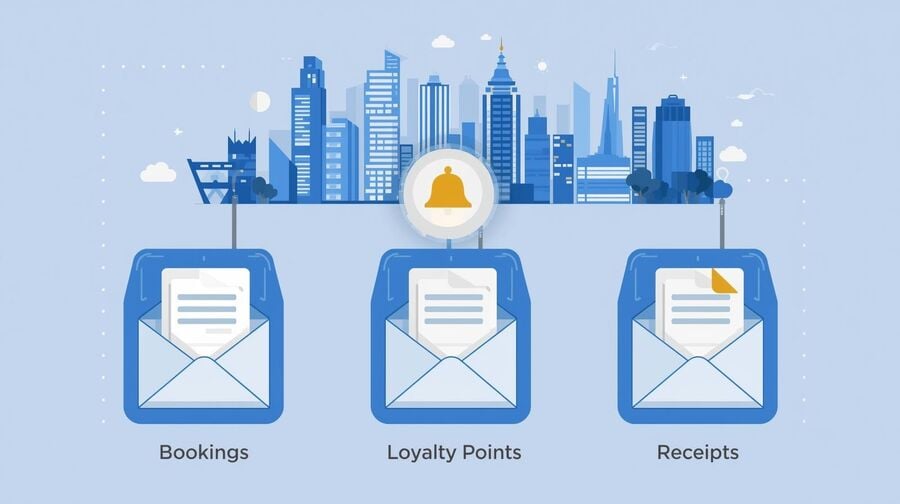
Let hotel and loyalty messages live in their own lane so they never drown out timely updates from airlines or ground transportation.
Using Temp Mail for Hotel Account Creation
When you open an account for a single stay - especially with independent hotels or regional chains - there is a good chance you will never stay with them again. Creating an account with a temporary or secondary address reduces long-term noise without affecting your ability to manage the upcoming stay.
Segmenting Loyalty Programs with Reusable Addresses
For larger chains and meta-loyalty programs, a reusable temp address can act as a buffer. You log in with that address, receive promos and points digests there, and only forward specific confirmations or receipts to your primary inbox when needed. This keeps your core account list clean while still letting you mine loyalty programs for value.
Handling Receipts, Invoices, and Business Trips
Business travel is a special case. Expense reports, tax records, and compliance audits all rely on a clear and searchable record of invoices and confirmations. For this reason, most travelers should avoid using temporary email addresses entirely for corporate bookings.
If you already manage online shopping with a privacy layer, you have seen this pattern before. An e-commerce-oriented playbook, such as privacy-first e-commerce checkouts with temporary email addresses, demonstrates how to separate receipts and order confirmations from marketing noise; the same logic applies to hotels and long-term rental platforms.
Turning Hotel Newsletters into a Curated Deal Feed
Used well, hotel newsletters and loyalty emails can save significant money on future trips. Used poorly, they become another drip of FOMO. Routing these messages into a dedicated temporary inbox allows you to treat them like a curated deal feed: you open it deliberately before planning a trip, rather than being passively nudged every few days.
When your inbox is not overflowing, it becomes easier to notice the rare, genuinely valuable deals among the usual promotions, especially if you combine this with a structured approach to online receipts, such as the system described in "Keep Your Receipts Clean with Reusable Temp Mail."
Build a Nomad-Proof Email System
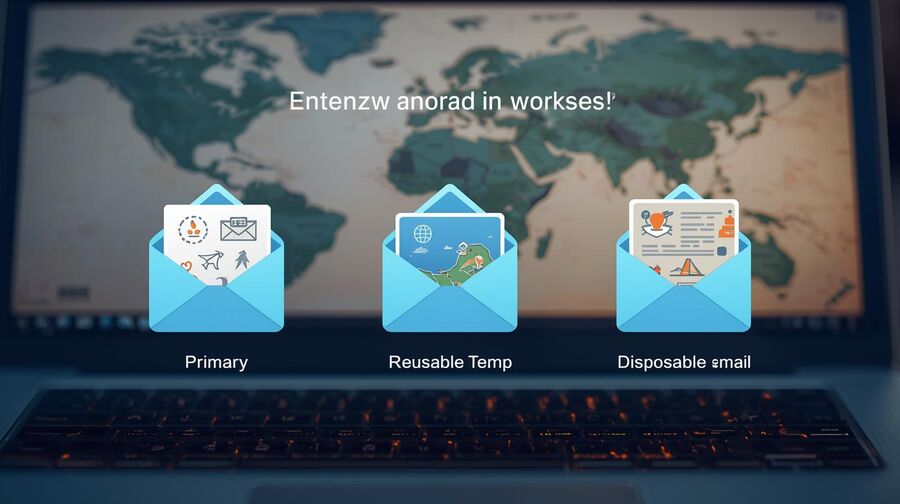
A simple three-layer email setup can support years of travel, remote work, and location changes without turning into a maintenance nightmare.
Designing a Three-Layer Travel Email Setup
A durable travel email architecture usually has three layers:
- Layer 1 – Primary inbox: long-term accounts, government IDs, banking, visas, insurance, and serious travel providers you plan to use for years.
- Layer 2 – Reusable temp address: loyalty programs, recurring newsletters, travel blogs, and any service you might want to revisit but that does not deserve a direct path into your primary inbox.
- Layer 3 – One-off disposable addresses: low-trust deal sites, aggressive marketing funnels, and experimental tools you are not sure you will keep.
Services like tmailor.com are built around this layered reality: you can spin up a temporary email address in seconds, reuse it across devices with a token, and let the inbox automatically hide older messages after 24 hours while the address itself stays valid. That gives you the flexibility of temporary email addresses without the "ten minutes and it is gone" anxiety.
Comparing Email Options for Travel
The table below summarizes how each email type behaves in typical travel scenarios.
| Use Case | Primary Email | Reusable Temp Address | One-Off Disposable |
|---|---|---|---|
| Flight tickets and schedule changes | The best choice is long-term access and reliability. | Risky for complex itineraries or long lead times. | Should be avoided; the mailbox may disappear. |
| Flight and hotel price alerts | It can cause noise and distraction. | Good balance for serious deal hunters. | Works for short tests; no long-term history. |
| Hotel loyalty and newsletters | Quickly clutters the main inbox. | Ideal for ongoing promos and points digests. | Usable for one-time accounts, you will be abandoned. |
| Travel blogs and general deal sites | High noise, low unique value. | Fine if you regularly check the feed. | Perfect for one-click trials and experiments. |
Using Labels and Filters with Temp Mail
If your temp mail service allows forwarding or aliases, you can combine them with filters in your primary inbox. For example, you might forward only mission-critical messages from a reusable travel address into your primary account and auto-label them "Travel – Confirmations." Everything else remains in the temp inbox.
Syncing Travel Emails Across Devices Securely
Digital nomads often bounce between laptops, tablets, phones, and shared machines. Whenever you log into a temporary email account on a public device, assume that device is untrusted: avoid saving login tokens, log out fully, and never reuse the same password across different services. A temporary email address reduces the blast radius of a compromise, but it cannot address poor device hygiene.
When to Migrate a Temp-Based Account to a Permanent Email
Over time, some accounts outgrow their temporary status. Signs that it is time to migrate include:
- You have stored payment methods or large balances in the account.
- The service now forms a core part of how you plan trips.
- You will need records from the account for tax, visa, or compliance reasons.
At that point, updating the login to a stable address is safer than continuing to rely on a temp mailbox, no matter how convenient it felt at first.
Avoid Common Travel Email Risks
Use a temporary email as a shield, not as a crutch that hides essential consequences of your bookings and purchases.
Refunds, Chargebacks, and Documentation Problems
When things go wrong - such as refund disputes, schedule disruptions, or cancellations - the strength of your documentation matters. If your only proof of purchase or communication with a provider lives in a forgotten throwaway inbox, you have made life harder for yourself.
Using temp mail is not inherently irresponsible, but you should be deliberate about which transactions leave a paper trail tied to your long-term identity and which ones can safely remain in a more disposable channel.
Using Temp Mail for Insurance, Visa, and Government Forms
Most formal processes, such as visa applications, residency applications, tax filings, and various types of travel insurance, require a stable financial situation. They assume the email address you provide will be reachable for months or years. This is not the place for disposability. A temporary address may be suitable for an initial quote, but final policies and official approvals should be stored in a permanent inbox that you control for the long term.
How Long Should Temporary Inboxes Stay Accessible
If you rely on a temp mailbox for any travel-related communication beyond pure promotions, keep it accessible at least until:
- Your trip has come to an end, and all refunds and reimbursements have been processed.
- Chargeback windows have closed for major purchases.
- You are confident that no additional documentation will be requested.
Reusable temporary mail systems, such as tmailor.com, help here by decoupling the lifetime of an address from the lifetime of a message: the address can live indefinitely, while older emails quietly age out of the interface after a defined window.
A Simple Checklist Before Using Temp Mail on Any Travel Website
Before entering a temporary email address on a travel site, ask yourself:
- Is money or legal responsibility attached to this transaction?
- Will I need to provide proof of any of these details within six to twelve months?
- Does this account hold points, credits, or balances I care about?
- Will I need to pass OTP or 2FA checks to regain access later?
- Is this provider stable and trustworthy, or just another aggressive lead funnel?
If you answer "yes" to the first four questions, use your primary inbox. If most answers are "no" and it appears to be a short-term experiment, a temporary address is probably appropriate. For more inspiration on edge cases and creative uses, see the scenarios discussed in 'Unexpected Use Cases of Temp Mail for Travelers'.
The bottom line is that a temporary email can make your travel life quieter, safer, and more flexible - as long as you keep the line clear between the noise you are happy to discard and the records you cannot afford to lose.
How to Set Up a Travel-Friendly Email System
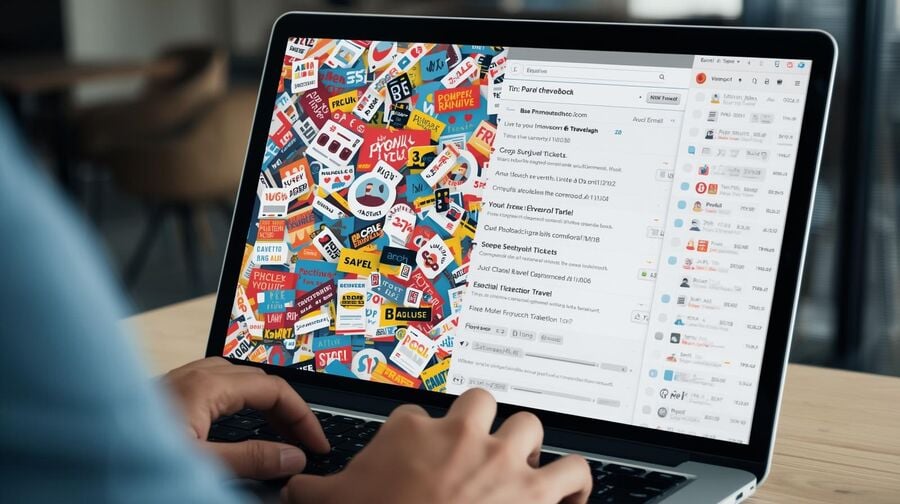
Step 1: Map your current travel email sources
Open your primary inbox and list airlines, OTAs, hotel chains, deal sites, and newsletters that send you travel emails. Note which ones you care about long term and which ones you barely remember subscribing to.
Step 2: Decide what must stay in your primary inbox
Mark anything related to tickets, invoices, visas, insurance, and formal travel documents as "primary only." These accounts should never be created or managed through short-lived, disposable email.
Step 3: Create a reusable temp address for travel
Use a service like tmailor.com to create a reusable temporary inbox that you can reopen with a token. Reserve this address for loyalty programs, newsletters, and travel blogs so their messages never touch your primary inbox.
Step 4: Redirect low-value sign-ups to temp mail
The next time a site asks for your email to "lock deals" or "etc., "use your reusable temp address instead of your main one. This includes fare alerts, general travel inspiration, and early-access sales.
Step 5: Reserve one-off disposables for experiments
When testing an unknown deal site or aggressive funnel, spin up a single-use disposable address. If the experience is poor or spammy, you can walk away without any long-term inbox damage.
Step 6: Build simple labels and filters
In your primary inbox, create labels such as "ravel – Confirmations" and "ravel – Finance." If you ever forward key emails from your temp inbox, have filters ready to label and archive them automatically.
Step 7: Review and clean your setup after each trip
After a significant journey, I reviewed which services were actually helpful. Promote a few to your primary inbox if they earned long-term trust, and quietly retire temp addresses tied to services you no longer plan to use.
FAQ

Is it safe to use a temporary email for flight deal alerts?
Yes, flight deal and price alert tools are a good match for a temporary email because they usually send informational messages rather than critical tickets. Just ensure that you do not route actual booking confirmations or boarding passes through a short-lived, disposable inbox.
Can I use temp mail for actual flight tickets and boarding passes?
It is technically possible, but rarely wise. Tickets, boarding passes, and schedule changes should be sent to a stable inbox that you will control for years, especially if you may need refunds, chargebacks, or documentation for visas and insurance.
What about using a temporary email for hotel bookings?
For casual leisure stays booked through well-known brands, a reusable temp address can work as long as you keep access to that inbox throughout the trip. For corporate travel, longer stays, or matters related to tax and compliance, it is recommended to use your primary email.
Do temporary email addresses expire before my trip finishes?
It depends on the service. Some disposable inboxes vanish after minutes or hours. At the same time, reusable temporary email—like the token-based approach used by tmailor.com—lets the address remain live indefinitely, even if older messages are no longer visible. Always check the retention policy before relying on a temporary inbox for time-sensitive itineraries.
Should I use a temporary email for travel insurance or visa applications?
Generally no. Insurance policies, visa approvals, and government documents expect a stable point of contact. You can use temporary email addresses for initial quotes or research, but final policies and formal paperwork should be sent to an inbox you will not abandon.
Can airlines or hotels block temporary email domains?
Some providers maintain lists of known disposable domains and may refuse sign-ups from those addresses. Temp mail platforms that utilize multiple domains and robust infrastructure are less likely to be blocked; however, you should still be prepared to fall back to a standard email address for essential bookings or loyalty accounts.
Is a temporary email valuable for digital nomads who travel full-time?
Yes. Digital nomads often rely on multiple booking platforms, coworking spaces, and travel tools that love to send emails. Using temporary email addresses for newsletters, promotional-heavy services, and one-off trials helps keep the primary inbox focused on financial, legal, and long-term accounts.
Can I forward travel emails from a temp inbox to my primary email?
In many setups, you can, and it is a good strategy for important messages. A typical pattern is to keep most travel marketing in the temp inbox but manually forward critical confirmations or receipts to your main account, where they are backed up and searchable.
What if I lose access to my reusable temp address while traveling?
If you have used temporary email addresses only for deals, alerts, and newsletters, the impact is minor—you stop receiving promotions. The real risk arises when tickets, invoices, or OTP-gated accounts are tied to that address, which is why they should be kept in a permanent inbox from the start.
How many travel-related temp addresses should I create?
You do not need dozens. Most people do well with one reusable travel address and occasional one-off disposables for experiments. The goal is simplicity: if you cannot remember what a temp address is for, you will not remember to check it when something important happens.
